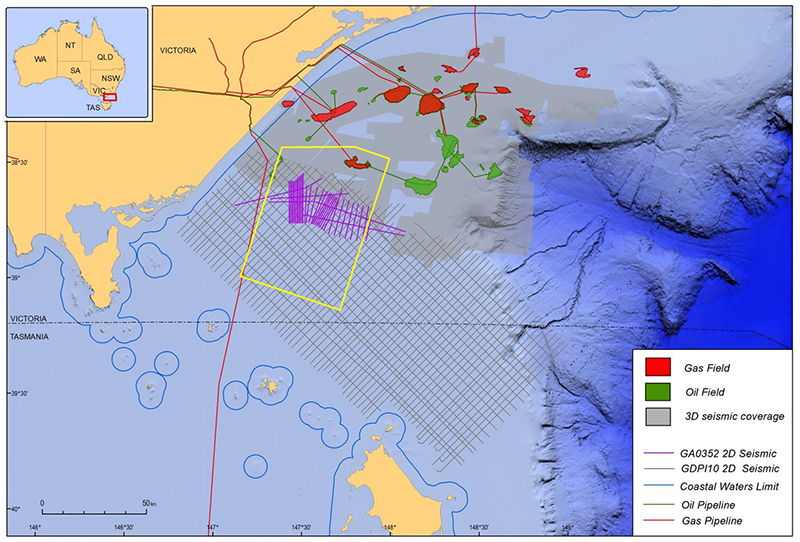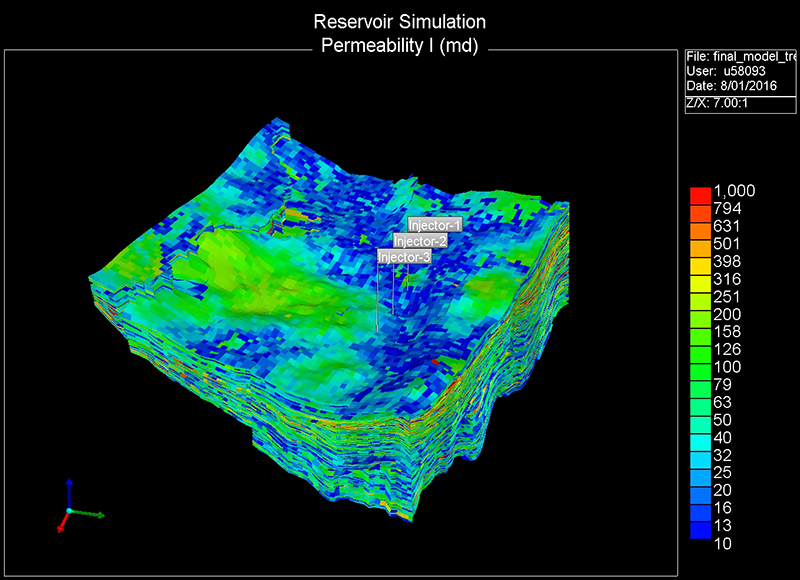Gippsland Basin CO2 Storage Project
Page last updated:27 April 2017
Project Overview
As part of the four-year National CO2 Infrastructure Plan (NCIP), Geoscience Australia conducted a CO2 storage capacity assessment and seismic data acquisition program in the offshore Gippsland Basin. The project was undertaken to accelerate the identification of suitable long term CO2 storage sites near the sources of major energy and production emissions in the Gippsland region in Victoria. The study built on previous CO2 storage studies in collaboration with the Geological Survey of Victoria VicGCS program and CSIRO.
The Gippsland Basin has been actively explored and has produced hydrocarbons since the 1960s. It contains numerous giant oil and gas fields that are located in the central and northern part of the basin, including the Kingfish, Marlin and Barracouta fields. The Latrobe Group is the major reservoir unit in the basin and the overlying Lakes Entrance Formation is the regional top seal unit. The offshore Gippsland Basin has been identified by previous storage prospectivity studies as highly prospective for long-term, high capacity CO2 storage. Potential CO2 storage sites that could become available in the next 10-20 years will probably be restricted to sites in the nearshore and southern parts of the offshore Gippsland Basin. This is in order to minimise possible overlaps with ongoing petroleum production in the northern and central parts of the offshore basin and onshore aquifers. Large areas in the southern and nearshore margin were released as areas for Greenhouse Gas Storage Assessment and were gazetted in 2009 and 2014.
The project focused on the CO2 storage potential of the underexplored southernmost part of the Central Deep, Southern Terrace and Southern Platform areas within the basin. A pre-competitive 2D reflection seismic survey, GA0352, was acquired in the southern part of the basin in 2015 as part of the project to provide new data to support future CO2 storage activities. The seismic survey was designed to tie the existing extensive 3D seismic coverage in the central part of the basin to the southern part of the basin, so seismic lines were shot perpendicular to the main structural trend of the basin. The survey has improved seismic data density in an area with widely-spaced seismic lines that were acquired in 2010 as part of the VicGCS program. Bathymetric data was also acquired during the survey.
Location of the GDPI10 and GA0352 2D seismic reflection surveys and the extent of 3D seismic coverage in the Gippsland Basin and the location of the geological modelling and reservoir simulation study area (yellow boundary).
Scientific Objectives
The study focused on assessing several factors that are critical to understanding the CO2 storage potential of the southern Gippsland Basin. These include:
- the effect of coal within reservoir units on potential CO2 migration and storage;
- the seal quality of the lower Seaspray Group;
- an analysis of potential CO2 storage sites in the southern part of the basin; and
- CO2 injection rates and storage capacity in the upper Latrobe Group
Marine biological studies on the potential impacts of seismic noise on fish and other commercial species were also undertaken in the project to monitor the impact of seismic activities on marine life, as it is not yet fully understood.
Scientific Results
As coal measures are common within potential CO2 reservoirs in the Latrobe Group, and due to the complexity of coal-CO2 effects, reservoir simulations of CO2 storage in the Gippsland Basin should consider the nature and distribution of coal in the CO2 migration and storage process. The migrating CO2 acts to displace adsorbed methane within the coal. At the same time, the adsorption of CO2 leads to coal swelling that decreases the permeability. Therefore, even if the coal seams were not seals, they would act to retard and spread the CO2, and increase potential residual trapping and dissolution of CO2. The key property that determines if coal seams can act as seals to the vertical migration of CO2 is the CO2 capillary entry pressure. In general, coals become increasingly water wet and have higher capillary entry pressure as the coal rank decreases; therefore, the low rank coals of the Gippsland Basin are likely to be water wet and essentially act as intraformational seals. However, if higher rank coals are present, the capillary entry pressure would be low and therefore their potential to act as intra-formational seals would be limited.
A detailed study was undertaken on a major deformed zone located along the southern part of the basin to examine if the seal integrity of the regional seal facies, the Lakes Entrance Formation, has been compromised. The deformed or slump zone is associated with a series of sedimentary mass transport deposits that straddle the southernmost Central Deep, and parts of the Southern Terrace and Southern Platform areas in the basin. The study has concluded that the seal has probably not been compromised across the entire area underlying the slump zone; however, it is recommended future site investigations acquire high resolution 3D seismic data over potential fluid migration pathways to fully access the risk proposed by this feature, and other geological aspects of the seal.
An analysis of potential CO2 storage sites in the southern part of the basin was undertaken by detailed geological mapping and modelling of a selected area that contained potential reservoir facies in the upper part of the Latrobe Group, an overlying effective regional seal unit, and a lack of overlap with ongoing and potential hydrocarbon production. A series of numerical and analytical fluid flow simulations of the selected area indicated that it is feasible to achieve injection and containment of commercial scale volumes of CO2 in this basin without adversely impacting existing resources.
Horizontal permeability values (scale in millidarcies; logarithmic scale) in the upper Latrobe Group reservoir simulation model.
The modelling studies suggest that future CO2 storage sites in the southern margin of the Gippsland Basin should be located in the Central Deep part of the basin. Large areas of the adjacent Southern Terrace, particularly in the nearshore areas of the terrace, have less potential for CO2 storage due to uncertainties regarding the effectiveness of the regional seal. The Southern Platform of the offshore Gippsland Basin is considered to be not viable for CO2 storage due to thin nature of the potential reservoir sequence and lack of an effective regional seal capacity. The study also demonstrated that CO2 storage injection rates in the Halibut and Cobia sub-groups in the upper part of the Latrobe Group of 2-3 Mtpa per well are realistic, due to permeability variations in the Halibut Sub-Group sequences. Previously proposed injection rates of up to 10 Mtpa per well are considered not feasible.
The 2D marine seismic data from survey GA0352 was processed in 2016 and has provided an opportunity to use the latest de-ghosting processing technology to better image faults and coal horizons, as well as to clarify depositional systems. The field data and processed seismic data are available from Geoscience Australia.
Overall, the offshore Gippsland Basin is considered to be highly prospective for CO2 storage. An extremely high potential storage capacity resource of tens of gigatonnes (Gt) exists within sequences of the Latrobe Group across the entire basin due to the relatively high porosity of the unit. This potential storage estimate includes about a gigatonne of potential CO2 storage capacity resource in existing hydrocarbon fields in the offshore Gippsland Basin; however access to this resource awaits depletion of those fields, and not all of this pore space will be accessed by CO2 due to reservoir engineering considerations. Future large-scale CO2 storage projects in the next 10-20 years will be probably limited to the Central Deep part of the basin. These projects will require detailed high-resolution 3D seismic data sets to underpin modelling and planning, a thorough knowledge of the basin-wide impact of any project, and collaboration with hydrocarbon operators in the basin.
Products and Publications
- Langford, R.P., Bernecker, T., Connell, L., Dance, T., Lupton, N., Michael, K., Mitchell, C.H., Nguyen, D., O'Brien, P.E. and Ricard, L., 2016. Carbon dioxide storage potential of the Gippsland Basin: results of a study undertaken as part of the National CO2 Infrastructure Plan. Record 2016/32. Geoscience Australia, Canberra.
- Gunning, M., Mitchell, C.H. and Langford, R.P. 2016. Gippsland Basin 2D Infill 2015 Marine Seismic Survey - GA0352: Acquisition and Processing Reports. Record 2016/25. Geoscience Australia, Canberra.
- Spinoccia, M. 2015. Gippsland 2D Infill 2015 Marine Seismic Survey, (GA-0352) - High Resolution Bathymetry Grids. Geoscience Australia.
- Gunning, M., Mitchell, C.H. and Langford, R. 2016. Gippsland Basin southern margin infill 2D seismic. PESA News No 141, 44-45.
- Langford R., Borissova I., Chirinos A., Henson P. and Heap A., 2013. Pre-competitive data acquisition program for CO2 storage in Australia. Energy Procedia 37, 4968-4974.
- Przeslawski, R., Bruce, B., Carroll, A., Anderson, J., Bradford, R., Durrant, A., Edmunds, M., Foster, S., Huang, Z., Hurt, L., Lansdell, M., Lee, K., Lees, C., Nichols, P. and Williams, S. 2016. Marine Seismic Survey Impacts on Fish and Invertebrates: Final Report for the Gippsland Marine Environmental Monitoring Project. Record 2016/35. Geoscience Australia, Canberra.
- Sea floor Imagery Data, AUV imagery from the Gippsland Basin (GA350 - 'Before' survey, GA353 - 'Short-term after' survey, GA355 - 'Long-term after' survey ).
- Carroll A.G., Przeslawski R., Duncan A., Gunning M. and Bruce B. 2017. A critical review of the potential impacts of marine seismic surveys on fish and invertebrates. Marine Pollution Bulletin 114 (1) 9-24.
- Blevin J., Cathro D., Nelson G., Vizy J. and Lee J.D., 2013. Survey GDPI10 interpretation project, Southern Flank, Gippsland Basin. VicGCS Report 8, Department of Primary Industries.
- Green C., Michael K. and Paterson L., 2013. Reservoir simulation of carbon dioxide geological storage in the Gippsland Basin. VicGCS Report 5, Department of Primary Industries.
- McLean, M.A. and Blackburn G.J., 2013. A new regional velocity model for the Gippsland Basin. VicGCS Report 9, Department of Primary Industries.
- O'Brien G.W., Goldie Divko, L.M., Tingate, P.R., Miranda, J.A., Campi, M. J. and Liu, K., 2013. Basin-scale fluid flow in the Gippsland Basin: implications for geological carbon storage. Australian Journal of Earth Sciences 60(1), 59-70.
- Hoffman, N., Arian, N. and Carmen, G., 2012. Detailed seal studies for CO2 storage in the Gippsland Basin. In: Mares, T. (Ed.), Eastern Australasian Basins Symposium IV. Petroleum Exploration Society of Australia, Special Publication, CD-ROM.
- Goldie Divko, L.M., O'Brien, G.W., Tingate, P.R. and Harrison, M.L., 2009. Geological carbon storage in the Gippsland Basin, Australia: Containment Potential. GeoScience Victoria VicGCS Report 1. Department of Primary Industries.

